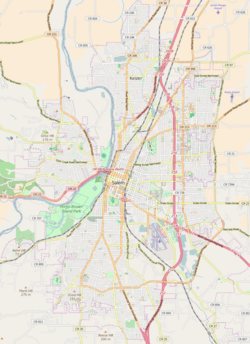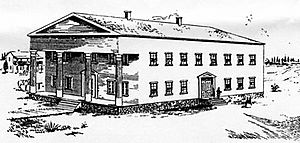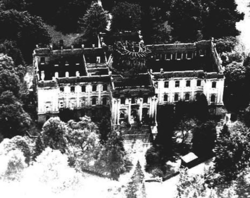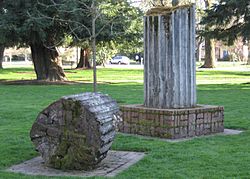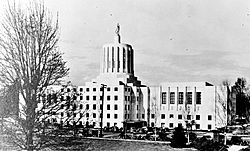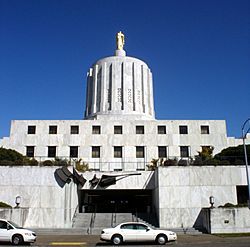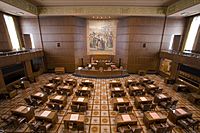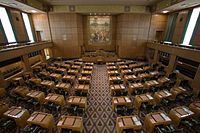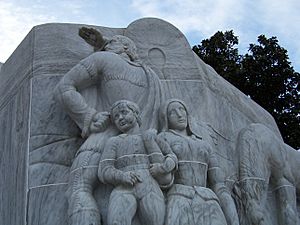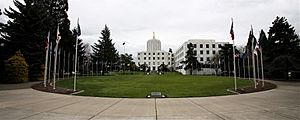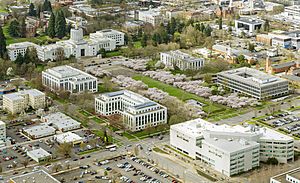Oregon State Capitol facts for kids
Quick facts for kids |
|
|
Oregon State Capitol
|
|
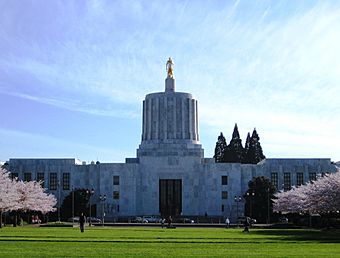
Oregon State Capitol, view from Capitol Mall
|
|
| Location | 900 Court Street NE, Salem, Oregon, U.S. |
|---|---|
| Built | October 1, 1938 |
| Architect | Trowbridge & Livingston |
| Architectural style | Art Deco, Stripped Classicism |
| NRHP reference No. | 88001055 |
| Added to NRHP | June 29, 1988 |
The Oregon State Capitol is the building housing the state legislature and the offices of the governor, secretary of state, and treasurer of the U.S. state of Oregon. It is located in the state capital, Salem. Constructed from 1936 to 1938 and expanded in 1977, the current building is the third to house the Oregon state government in Salem. The first two capitols in Salem were destroyed by fire, one in 1855 and the other in 1935.
New York architects Trowbridge & Livingston conceived the current structure's Art Deco stripped classical design in association with Francis Keally. Much of the interior and exterior is made of marble. The Oregon State Capitol was placed on the National Register of Historic Places on June 29, 1988.
The federal government's Public Works Administration partially financed construction which was completed during the Great Depression in 1938. The building was erected at a cost of $2.5 million for the central portion of the building, which includes a dome of 166 feet (51 m). The wings, which doubled the floor space of the building to about 233,750 square feet (21,716 m2), were added later for $12.5 million. The grounds outside the capitol building contain artwork, fountains, and flora, including the state tree (Douglas fir) and state flower (Oregon grape).
Contents
Early capitol buildings
Before the creation of the Oregon Territory in 1848, the Oregon Country provisional government, through legislation on June 27, 1844, and December 19, 1845, selected Oregon City as Oregon's first capital. J. Quinn Thornton described an early capitol building as 20 by 40 feet with a platform at one end for the president. One of the private buildings this government used was constructed by John L. Morrison in 1850; it served as a capitol until the government moved to Salem. Governor Joseph Lane affirmed Oregon City's status as capital by proclamation. In 1850, the legislature passed an act designating Salem the capital. However, Governor John P. Gaines refused to relocate, on the basis that the same act located the university in Corvallis and the penitentiary in Portland; he declared the act unconstitutional, on the grounds that the authority to locate those institutions was his, and the Territorial Supreme Court concurred; the governor and most of the Supreme Court remained in Oregon City. Justice Orville C. Pratt, who had dissented, relocated to Salem; on May 14, 1852 an act of the United States Congress settled the matter in Salem's favor.
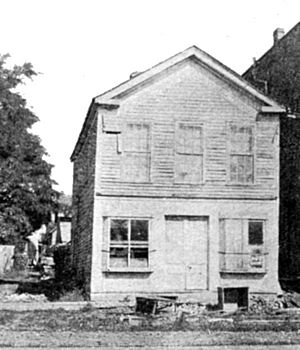
On January 13, 1855, the Oregon Territorial Legislature passed a bill moving the seat of government from Salem to Corvallis. Governor George Law Curry and many others objected to the move, since public buildings in Salem were already under construction. Curry sent the matter to the Secretary of the Treasury in Washington, D.C., where Secretary James Guthrie declared the move invalid unless acted on by the United States Congress. Thereafter, Curry and Oregon Secretary of State Benjamin Harding moved back to Salem.
On December 3, 1855, the legislature convened in Corvallis and quickly introduced legislation to move the capital back to Salem. This bill passed on December 15, 1855. Three days later, the legislature re-convened in Salem. However, the statehouse burned down on the 29th, and the legislature re-opened debate about where to seat the capital. They decided to ask the people of the territory to vote on the question. A vote was to be held in June 1856, after which the two cities receiving the most votes would have a runoff. The initial vote set up a runoff between Eugene and Corvallis, but after some ballots were invalidated due to not being cast in accordance with the law, the two winners were Eugene and Salem. An October runoff gave Eugene the most votes, but the earlier vote-tossing led to a low turnout. With such low public participation, the election was ignored, and the capital remained in Salem.
A permanent resolution of the capital location issue came in 1864. In 1860, the legislature put the question once again to a popular vote. On a vote in 1862, no city received the 50 percent minimum required by law. In an 1864 election, Salem received 79 percent and was declared the state capital. The Oregon Constitution lists the seat of state government in Article XIV as Marion County, of which Salem is the seat.
First capitol
The land developed for the permanent capitol buildings was Salem block 84, sold to the state for this purpose by pioneer and Salem founder W. H. Willson. Construction of the first capitol building began in 1854, shortly after Congress confirmed Salem as the capital city. However, with the capital moving to Corvallis the next year, construction was temporarily halted. After the capital's return to Salem, the building was nearly completed by late 1855. This territorial capitol, of Greek Revival-style, stood 50 feet (15 m) wide and 75 feet (23 m) long (15 by 23 m), with a stone facade and a 10-foot (3 m) portico. Built of native ashlar blocks, the exterior walls, two stories high, ranged in color from a deep sky blue to white. The first floor was 19 feet (5.8 m) tall and the second 15 feet (4.6 m) tall with an eight-foot (2.4 m) entablature. The building was decorated with four Ionic columns on the front (west) end. The building housed a variety of rooms, including a federal courthouse with a chamber measuring 20 by 27 feet (6 by 8 m) and an executive office of 18 by 20 ft (5.5 by 6 m) on the first floor. Also on the first floor was the House chamber, measuring 36 by 46 feet (11 by 14 m) and having three entrances. The first floor also held the main hall, which included an entrance 15 feet (5 m) wide. On the second floor was the Senate chamber, 26 by 36 feet (8 by 11 m). Additionally, the Territorial Library was housed in a room that was 20 by 36 feet (6 by 11 m). The second story also had a gallery viewing area for the House, three committee rooms, and several rooms for government clerks. The capitol was designed by Captain Charles Bennet, who participated in the discovery of gold at Sutter's Mill in 1848, and construction supervised by William H. Richter at a total cost of $25,000.
Fire
On the evening of December 29, 1855, a fire destroyed the first capitol building and many of the territory's public records. Starting in the unfinished northeast corner of the structure, still unoccupied by the government, the fire was not discovered until around 12:30 am. Arson was suspected, but no one was arrested.
The site of the burned-out capitol building remained a pile of stones for several years after the fire. A downtown building, Nesmith's Building (later named the Holman Building), served as a temporary capitol from 1859 until 1876. The legislature met on the second and third floors of that building, which also housed the other state offices.
Second capitol
Plans for a new building began to take shape in 1872 when the state legislature appropriated $100,000 ($ 2.4 million as of 2025) towards a new capitol building. This second capitol, built between 1873 and 1876, was a two-story structure with an additional first level that was partly underground; the total cost was $325,000 ($ 8.9 million as of 2025). The cornerstone for the building was laid on October 5, 1873, during a ceremony that included a speech by Governor Stephen F. Chadwick and the music of several bands. Construction, on the same site as the 1855 building, was partly accomplished with convict labor from the Oregon State Penitentiary. Architects Justus F. Krumbein and W.G. Gilbert designed the building.
Built of stone and five million bricks, Oregon's new capitol measured 275 by 136 feet (84 by 41 m) with a dome of 180 feet (55 m). The ground story was of native Oregon sandstone from the Umpqua region. The structure had a square rotunda on the interior that was 54 feet (16 m) tall. Also inside was a Senate chamber measuring 75 by 45 feet (23 by 14 m) and a House chamber of 85 by 75 feet (26 by 23 m). On the top floor was the Oregon Supreme Court with a courtroom measuring 54 by 45 feet (16 by 14 m) and the Oregon State Law Library, 75 by 70 feet (23 by 21 m). Also on the top floor was a viewing gallery for the House. On the exterior were ornamental pilasters and two-story porticos on the east and west ends. The building included a lunch counter. Additionally, the building had mullion-windowed wings. The large copper-clad dome was constructed with an iron and steel framework. This dome rose 54 feet (16 m) above the rest of the building and was 100 feet (30 m) tall. The building was of Renaissance style with Corinthian columns on the front entrance and was patterned after the United States Capitol. At that time, the capitol faced west toward the Willamette River. The government began using the building in August 1876, before the dome was built. Originally, plans called for towers on both sides of the dome (a tower on both ends of the building with the dome in the middle), but they were left out to save money. Oregon's second capitol building stood from 1876 to 1935.
Fire
On April 25, 1935, at 6:43 pm, a custodial engineer called the Salem Fire Department to report smoke. Citizens helped to remove items from the smoky building, but when firefighters arrived, they ordered everyone to leave the structure, which was soon engulfed in flame. Among the helping citizens was twelve-year-old Mark Hatfield, who later became governor. It was determined the fire started in the basement of the east wing and quickly spread to piles of old records. A strong updraft in the hollow columns enclosing the dome's eight supporting steel lattice girders pulled the flames through the rotunda to upper stories. The intense heat burned even the copper dome and lit the night sky.
Flames could be seen as far away as Corvallis. One volunteer firefighter, Floyd McMullen, a student at Willamette University, died in the fire, which drew firefighters from as far away as Portland. Salem sent seven fire trucks to the scene; three more came from Portland. Only the outer walls were left standing after the fire was extinguished. Losses were estimated at $1.5 million ($ 32 million as of 2025), and the state did not carry insurance. The losses, which included historic artifacts such as the portraits of all the governors, could have been worse had the state not used fire-proof vaults in the basement to store valuables such as more than $1 million ($ 21.3 million as of 2025) in stocks and bonds. During the blaze, firefighters poured water on these vaults to help keep them cool and prevent the contents from disintegrating. Years earlier, the state had turned over many historical documents to the Oregon Historical Society in Portland for preservation, and those records were preserved. Although the Supreme Court had moved to the Oregon Supreme Court Building in 1914, the two buildings were connected by tunnels used for electricity and heating. At the time of the fire, the Oregon State Library was in the basement and first floor of the Supreme Court Building. Many books in the basement suffered water damage when water used to fight the fire flooded tunnels and seeped into the Supreme Court Building. Offices previously housed in the capitol were moved to other government buildings and to leased space in downtown Salem until a new building was built.
Third capitol
Construction of the newest building began on December 4, 1936. The third state capitol was completed June 18, 1938 and is the fourth-newest capitol in the United States. The capitol was dedicated on October 1, 1938, with speeches from President Franklin D. Roosevelt, Leslie M. Scott, Robert W. Sawyer, and Oregon Governor Charles Henry Martin. Chosen from 123 entries in a countrywide competition, the design of the new building deviated from the normal design of state capitol buildings. The design was labeled a combination of Egyptian simplicity and Greek refinement. Overall it is Art Deco in style, and is one of only three state capitols in the United States constructed in that architectural style.
Controversy occurred before construction began when Governor Martin suggested the new building be sited on a hill south of downtown (Candalaria Heights) and away from the busy center of town. Another proposal called for the purchase of the Willamette University campus and relocation of the capitol to that site. However, downtown merchants were able to keep the capitol building in downtown at the original location, though some Victorian homes were subsequently leveled to make way for the building. Another early complaint about the structure was that the cupola resembled a "paint can" rather than traditional domes on other capitols, including the earlier Oregon structures. It was even called a "squirrel cage", lacking in majesty. Additionally, the public was slow to admire the gold Oregon Pioneer atop the dome. Installation of the statue began on September 17, 1938, and took several days and heavy-duty equipment.
The building cost $2.5 million ($ 53 million as of 2025), of which the federal government paid 45 percent through the Public Works Administration. Upon completion, the new capitol was 164 feet (50 m) wide, 400 feet (120 m) long, and 166 feet (51 m) tall (50 by 122 by 51 m) and contained 131,750 square feet (12,240 m2) of usable space. The exterior was finished with Vermont marble. The lobby, rotunda, and halls were lined with a polished rose travertine stone quarried in Montana. The rotunda's staircases and floor used Phenix Napoleon Grey Marble quarried in Phenix, Missouri, and had borders of Radio Black marble that, like the exterior stone, is from Vermont. There are 158 names of notable Oregonians inscribed on the walls of the legislative chambers; of these, only six are women. The original cost estimate for the building was $3.5 million ($ 74 million as of 2025), but the state legislature only appropriated $2.5 million; committee rooms were subsequently removed from the plans. These rooms were added in 1977 as part of a $12.5 million ($ 60 million as of 2025) expansion project to add new wings containing legislative offices, hearing rooms, support services, a first floor galleria, and underground parking. This addition doubled the space of the capitol building. In 2002, the wings were remodeled at a cost of $1.3 million ($ 2.1 million as of 2025) to upgrade items such as antiquated wiring and to install new carpeting and lighting.
On March 25, 1993, the magnitude 5.6 Scotts Mills earthquake damaged the dome, requiring closure for repairs. The rotunda area remained closed for approximately two years for these repairs. This "Spring Break Quake" shook the building enough to shift the statue on top and crack the dome. Additionally, the quake created a three-foot (one-meter) bulge on the west end of the building. Repairs cost $4.3 million ($ 8.7 million as of 2025) and included reinforcing the structure with additional concrete and steel bars.
In April 2002, the building became the first state capitol in the United States to produce solar power through the use of 60 photovoltaic panels generating 7.8 kilowatts. One-third of the power is used to light the Oregon Pioneer at night; the remaining electricity is sent into the power grid.
On December 31, 2007, the Oregon State Capitol hosted its first authorized wedding between Oregon State Representative Tobias Read and Heidi Eggert. At Read's encouragement, the Legislature created a policy authorizing up to four public events a year. On August 30, 2008, the building caught fire around 12:30 in the morning and was quickly extinguished with damage to the Governor's offices on the second floor on the south side. The governor was forced to relocate some of his offices, including some time at the Oregon State Library across the street.
Exterior and interior
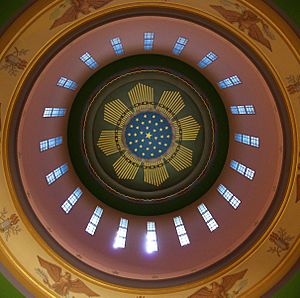
The Oregon State Capitol is home to both branches of the state legislature, the House and Senate, and has offices for the governor, treasurer, and the secretary of state. In its center, the floor of the prominent rotunda features an embedded Oregon State Seal sculpted in bronze by Ulric Ellerhusen. Ellerhusen also sculpted the Oregon Pioneer that rests atop the capitol dome's exterior. The dome rises 106 feet (32 m) above the state seal. The interior of the dome was painted by Frank H. Schwarz and features 33 stars, symbolizing Oregon's place as the 33rd state to join the Union. Eight medallions are painted near the top of the walls of the rotunda that represent the eight objects in the state seal. Also encircling the interior of the rotunda are four murals depicting moments from Oregon history. One mural depicts Captain Robert Gray's exploration of the Columbia River in 1792, another shows the Lewis and Clark Expedition, and two others portray covered wagons from pioneer times. These four murals were painted by Schwarz and Barry Faulkner. Other murals include the Provisional Government of Oregon's salmon and wheat seal, the Oregon Territory's seal, and depictions of Oregon's industries, all located in the rotunda's wings along the grand staircase. The capitol's galleria area on the first floor includes hearing rooms, display cases, and the visitor information area.
Oregon's House chamber floor is covered with a custom carpet; the carpet's pattern incorporates a depiction of the state tree, the Douglas-fir, representative of forestry. The furniture and paneling of the chamber is made of golden oak. A large mural painted by Faulkner, depicting the 1843 Champoeg Meetings at which the provisional government was formed, is behind the desk of the Speaker of the House. The Senate chambers use black walnut for the paneling and furniture. Another custom carpet lines the floor, featuring Chinook salmon and wheat, representative of fishing and agriculture. The Senate's large mural was painted by Schwarz and depicts a street scene showing news of statehood reaching Salem. Lining the walls of both chambers are 158 names, inscribed in friezes, of prominent people in Oregon's history. On the second floor of the capitol is the Governor's suite, consisting of a ceremonial office and private offices for the state's chief executive. As in the Senate chamber, the paneling is of black walnut. The ceremonial office includes a fireplace with a painting by Faulkner. In the suite's reception area is a table made of 40 tree species. This table is inlaid with a replica of Oregon's second capitol building, the state flower (Oregon-grape), and the state bird (western meadowlark).
A variety of artwork is displayed on the exterior of the building. Sculptor Leo Friedlander used Vermont marble for the large relief sculptures on both sides of the main entrance. One sculpture depicts Meriwether Lewis, William Clark, and Sacagawea, with a map of their expedition's route on the reverse (Lewis and Clark); the other (Covered Wagon) shows pioneers and a covered wagon, with a map of the Oregon Trail on the reverse. Additionally, Ellerhusen created five marble relief sculptures on the exterior, and a metal sculpture by Tom Morandi sits above the south entrance. Ellerhusen also cast six bronze sculptures arranged above the building's main entrance, three on the inside and three on the outside.
The building measures 693 by 259.5 ft (211.2 by 79.1 m). The older main portion of the building is 53.5 feet (16.3 m) tall, while the newer wings added in 1977 are 68.7 feet (20.9 m) tall. Inside, the building has approximately 233,750 square feet (21,716 m2) of floor area and 3.2 million cubic feet (90,600 cubic meters) of volume.
In 1997, the Legislative Assembly established the non-profit Oregon State Capitol Foundation in order to "create a living history, enhance the dignity and beauty of the Capitol, and foster cultural and educational opportunities." In 2005, the foundation completed the Walk of the Flags project, a display in Willson Park on the capitol grounds of all 50 flags of the U.S. states.
In 2007, the capitol wings closed for a restoration project to upgrade items such as furniture, plumbing, and electrical systems. The $34 million project became an issue in the 2008 Senate campaign between Gordon Smith and Jeff Merkley when Smith used the price of the project in ads attacking Merkley who was the Speaker of the Oregon House when the remodel was approved. Part of the attack involved the cost of new desks for legislators and staff that were manufactured by Oregon prison inmates. Renovations were completed in November 2008.
Grounds
The capitol grounds cover three city blocks and include Willson and Capitol parks. Near the west entrance of the capitol is a replica of Philadelphia's Liberty Bell. This bell is one of 53 full-sized replicas made in France and donated by the United States government to each state. Oregon received its copy on July 4, 1950. Throughout the grounds are native trees and shrubs, including blue spruce, Oregon-grape (the state flower), giant sequoia, coast redwood, Japanese maple, dogwood species, Bradford pear, cherry tree species, English holly, rhododendron, and magnolia tree species. One Douglas-fir tree was grown using a seed that rode aboard Apollo 14 to the Moon in 1971 and was transplanted to the capitol in 1976 from Oregon State University.
On the east side of the building is Capitol Park, which includes a bronze equestrian statue by A. Phimister Proctor called The Circuit Rider, statues of Jason Lee (Jason Lee) and John McLoughlin (John McLoughlin) by Gifford Proctor, and portions of the Corinthian columns of the second capitol building. Lee established the Methodist Mission and what would become Willamette University. McLoughlin, of the Hudson's Bay Company, was proclaimed the Father of Oregon. The Circuit Rider was added in 1924 as a monument to early preachers. During the Columbus Day Storm in 1962, this statue was knocked over and damaged but restored in 1963. There is also a memorial to Oregon's recipients of the Medal of Honor, dedicated on September 18, 2004.
To the west of the building is Willson Park, named for Salem founder William H. Willson and sited roughly at the center of his former landholdings. From 1853 to 1965 it was a Salem city park. After the park was turned over to the state, Lloyd Bond and Associates were asked to redesign the park. Willson Park has the Waite Fountain, a gazebo built in 1982, and Peter Helzer's sculpture, A Parade of Animals (1991), which was designed as a play structure. Waite Fountain was donated in honor of Oregon businessperson E. M. Waite in 1907 by his wife. The Breyman Fountain, added in 1904 as a memorial to Werner and Eugene Breyman, is at the far west end of the park. It was originally decorated with a statue of a soldier from the Spanish–American War and also served as a lamp post and horse trough. Today the statue holds no water and is sometimes planted with flowers. In 2005, a Walk of Flags feature was added that displays the flags of every state in the Union. In 2009, the nine flags of Oregon's federally recognized Native American tribes were added to the Walk of Flags.
Other features on the capitol grounds include Sprague Fountain and the Wall of Water. The Wall of Water is located across Court Street from the main entrance. It was added in 1990 and has 22 nozzles shooting water 12 feet (3.7 m) into the air in a plaza that also has slabs of stone with information about Oregon's history. Added in 1985, the Capitol Beaver Family sculpture represents the state animal. Additional features of the grounds include a peace pole donated by the Society of Prayer for World Peace, a large boulder that once lay along the Oregon Trail, a planter that spells out "Oregon" using shrubs, and a rose garden maintained by the Salem Rose Society.
See also
 In Spanish: Capitolio del Estado de Oregón para niños
In Spanish: Capitolio del Estado de Oregón para niños


